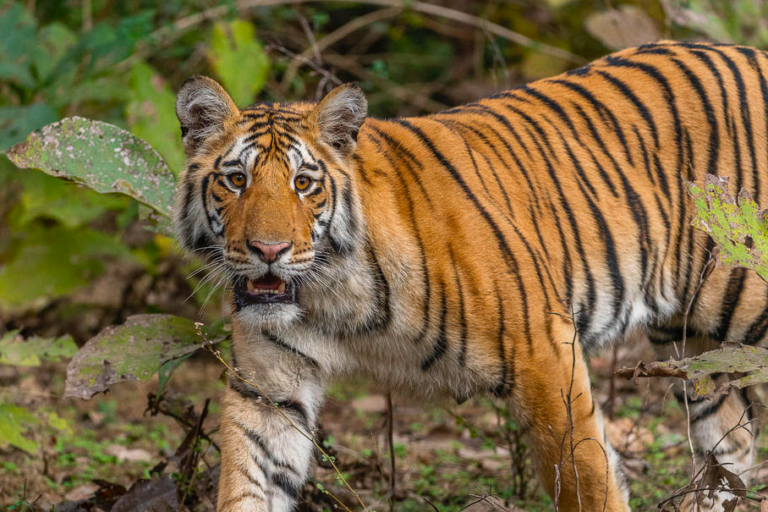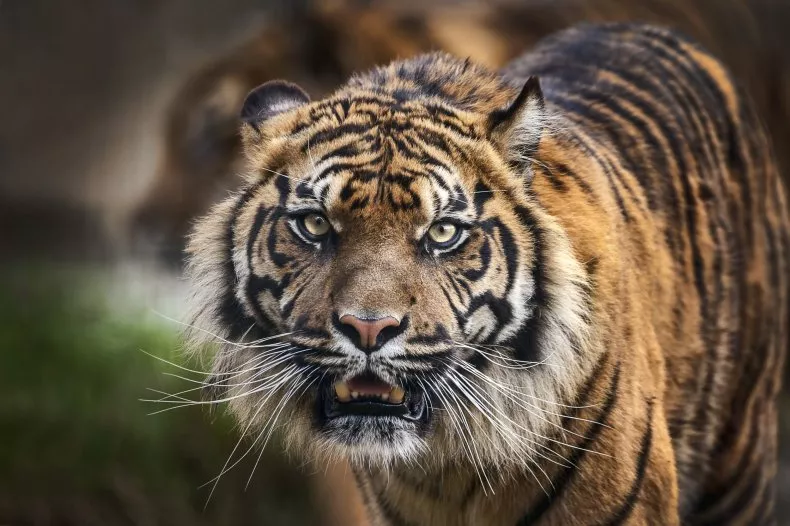KATHMANDU — Yes, you read the headline right: On Aug. 22, in a rare incident, a tethered domestic buffalo (Bubalus bubalis) killed an endangered Bengal tiger (Panthera tigris tigris) on the fringe of Nepal’s Chitwan National Park.
The event, which occurred in Pratappur village within the Manahari Rural Municipality, quickly made headlines across Nepal, with many users on social media marveling at the unusual role reversal.
However, beyond the initial reactions to the incident lies a broader and more crucial issue: ongoing human-wildlife conflict in Nepal and balancing conservation with securing people’s right to livelihoods.
The tiger, according to Dil Bahadur Purja Pun, chief conservation officer at Chitwan National Park, was likely severely injured and struggling to find prey in the wild. “We believe that the tiger attacked the buffalo, which was tethered to a shed, because it perceived the animal as easy prey,” Pun said. However, the buffalo fought back, goring the tiger to death.
Bal Bahadur Rai, the 56-year-old owner of the buffalo, said that while he was relieved his buffalo survived the attack, the animal was severely injured. “The buffalo’s neck, where the tiger attacked, is swollen, and it is unable to stand,” Rai told the Nepali news outlet Setopati.

Despite the severity of the buffalo’s injuries, park officials who arrived at the scene to take away the tiger’s carcass didn’t provide any treatment for the injured domestic animal, Rai said.
The South Asian country, which nearly tripled its tiger population between 2010 and 2022, is home to a wide variety of wild animals, including species such as elephants (Elephas maximus) and greater one-horned rhinos (Rhinoceros unicornis). However, as human populations grow due to migration and forest cover increases due to community forestry, incidents of human-wildlife conflict have become more frequent.
In the 2022-23 fiscal year, a total of 5,234 cases of livestock depredation were reported across Nepal, underscoring the scale of the problem.
The management authority for forests and wildlife in Nepal is shared by the federal Department of National Parks and Wildlife Conservation (DNPWC), which oversees protected areas, and the divisional forest offices under provincial forest ministries, which manage forested areas outside national parks.
The village of Pratappur, where the buffalo and tiger incident occurred, is situated within the buffer zone of Chitwan National Park, a protected area where human-wildlife conflicts are particularly common.
The park, also a UNESCO World Heritage site, is one of Nepal’s key protected areas, known for its successful conservation efforts, particularly with regard to tiger populations. The park has distributed approximately 23 million rupees ($171,000) in compensation and relief in the last fiscal year.
However, there are critical gaps in the compensation system, particularly for domestic animals injured by predators. Authorities currently do not even maintain data on injured livestock, and there is no provision for compensation in such cases.
Recognizing the need to address growing human-wildlife conflict, the government introduced new compensation guidelines last year. Effective from July 17, 2023, these guidelines expanded the list of animals for which compensation can be claimed from 14 to 16 species, adding the nilgai antelope (Boselaphus tragocamelus) and common monkeys (Macaca mulatta) to the list.

The guidelines also cover damages caused by animals such as elephants, rhinos, tigers, bears (Ursidae), leopards (Panthera pardus), snow leopards (Panthera uncia), clouded leopards (Neofelis nebulosa), wolves (Canis lupus), dholes (Cuon alpinus), wild boars (Sus scrofa), wild buffalo (Bubalus arnee), mugger crocodiles (Crocodylus palustris), pythons (Pythonidae) and gaur cattle (Bos gaurus).
The documents allow for compensation to be provided to Nepali nationals who are attacked by wild animals, as long as they don’t enter a protected area illegally. Compensation is also available for livestock, fish and fowl that are attacked, provided they are on private land.
Additionally, the guidelines provide for compensation if stored food items or crops planted on private land are damaged. Survivors of wildlife attacks who die within 35 days of hospital discharge are also eligible for compensation.
However, the guidelines still do not address compensation for domestic animals that are injured but do not die immediately as a result of wildlife attacks. “This omission is due to concerns about the potential economic burden on the government,” explained Maheshwor Dhakal, the former director-general of the DNPWC. Dhakal added that, depending on the economic status of the affected family, the local government or the national park may be able to provide some relief on a discretionary basis.
For Rai, the farmer whose buffalo is now gravely injured, the lack of support is a significant burden. The buffalo, which Rai purchased six months ago with a loan of 40,000 rupees (approximately $300), produced 8 liters (2 gallons) of milk daily, serving as a crucial income source for his family.
Despite the buffalo’s importance, and its severe injuries, Rai has received no assistance. “I applied toothpaste to the wound, but it hasn’t helped,” Rai said, indicating the limited resources available to him.
Ranjan Kalakheti, president of the Manahari Rural Municipality, stated that his office is prepared to provide financial assistance to victims of wildlife attacks but noted that Rai had not approached him for support.
This article by Abhaya Raj Joshi was first published by Mongabay.com on 24 August 2024. Lead Image: A Bengal tiger in the Khata Forest, which only 10 years ago was a degraded patch of land. This image was taken with a camera trap between November 2019 and March 2020 by WWF-Nepal.
What you can do
Help to save wildlife by donating as little as $1 – It only takes a minute.







Leave a Reply